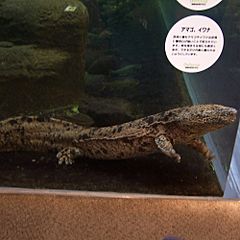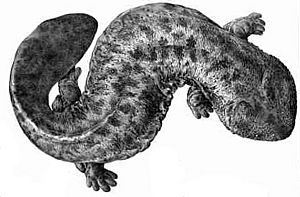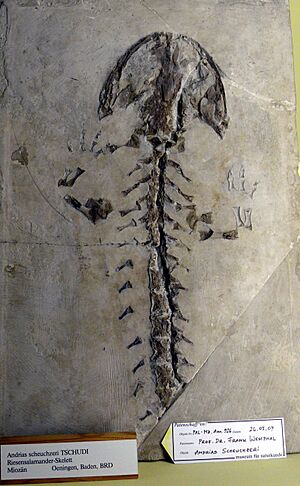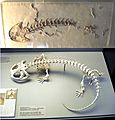Giant salamander facts for kids
Quick facts for kids Giant salamander |
|
|---|---|
 |
|
| Andrias japonicus | |
| Scientific classification | |
| Kingdom: | |
| Phylum: | |
| Class: | |
| Order: | |
| Family: |
Cryptobranchidae
|
Giant salamanders are a special group of large aquatic amphibians. They belong to a family called Cryptobranchidae. These amazing creatures are the biggest living amphibians on Earth!
The Japanese giant salamander (Andrias japonicus) can grow up to about 1.44 meters (4.7 feet) long. It loves to eat fish and crabs or shrimp. Some have lived for over 50 years in zoos. The Chinese giant salamander (Andrias davidianus) is even bigger, reaching up to 1.8 meters (5.9 feet)!
These amazing creatures live in brooks and ponds. You can find them in the eastern United States (where they are called hellbenders), and also in China and Japan.
Contents
What Giant Salamanders Look Like
Giant salamanders are big and have thick bodies. They have special folds of skin along their sides. These skin folds help them take in more oxygen from the water. It's like having extra breathing space!
When they grow up, they don't fully change like some other amphibians. Adult giant salamanders still have gill slits, which are small openings for breathing underwater. They also have lungs to breathe air. Unlike many animals, they don't have eyelids.
The Chinese giant salamander can live for a very long time. Some have lived for as long as 75 years in captivity. They eat insects that live in water, fish, frogs, and also crabs and shrimp.
How Giant Salamanders Hunt
Giant salamanders mostly hunt at night. They don't have very good eyesight. Instead, they use special sensors on their head and body. These sensors can feel tiny changes in water pressure. This helps them find their prey, even in the dark!
Reproduction and Life Cycle
During the mating season, these salamanders travel upstream in rivers. After the eggs are fertilized, the male salamander guards them. He protects the eggs for at least six months.
Once the young salamanders hatch, they live off their stored fat for a while. This fat helps them survive until they are ready to hunt on their own. When they are ready, they often hunt together in a group.
Scientists at Asa Zoo in Japan have learned something interesting. A male salamander might mate with more than one female in his den. Sometimes, the main male in the den even lets another male join him. Scientists are still trying to figure out why this happens.
Types of Giant Salamanders
There are different types of giant salamanders:
- Genus Cryptobranchus (these are the hellbenders)
- Hellbender (Cryptobranchus alleganiensis )
- Genus Andrias (these are the true giant salamanders)
- Chinese giant salamander (Andrias davidianus)
- Japanese giant salamander (Andrias japonicus)
- Genus Aviturus (Aviturus exsecratus)
- Genus Zaissanurus (Zaissanurus beliajevae)
- Chinese Giant Salamander from ARKive
Facts Status Description Range Habitat Biology Threats Conservation Find out more Glossary References View all
Images for kids
See also
 In Spanish: Salamandras gigantes para niños
In Spanish: Salamandras gigantes para niños





